1.
Lilly Library call number: PS2617 .A1 1841
Transcribed from:
Lilly Library call number: Z5917.D5 I39
An Exhibition Held at
The Lilly Library
Indiana University
Bloomington
July-September, 1973
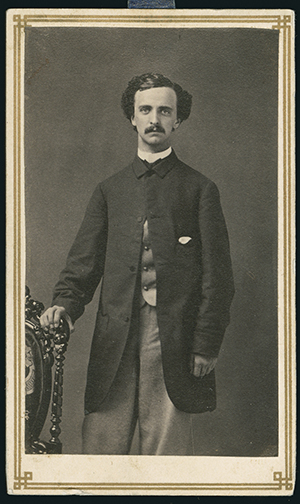
"The detective story is the normal recreation of noble minds." Philip Guedalla
Fiat Lux! declared Edgar Allan Poe and in the beginning was The Murders in the Rue Morgue. The detective story begins with its publication in the April, 1841 issue of Graham's Magazine. Howard Haycraft states in his excellent Murder for Pleasure: The Life and Times of the Detective Story (1941): "Clearly there could be no detective stories (and there were none) until there were detectives. This did not occur until the nineteenth century." Philip Van Doren has well said: "Like printing, the detective story has been improved upon only in a mechanical way since it was first invented; as artistic products Gutenberg's Bible and Poe's The Murders in the Rue Morgue have never been surpassed."
It is odd that the first detective stories should have been written by an American with the scenes laid in Paris. But we must recall that the Sûreté Générale and Scotland Yard were in existence at a time when American police methods had no such centralization, so Poe had no native types to draw upon. He knew Paris well, displaying wide knowledge of its police system and with the Memoirs (Paris, 1827) of the famed Vidocq, criminal turned cop. Charles Baudelaire translated Poe's tales magnificently in the 1850's and '60's when he was out-of-print in his own country, and the most impressive of all editions is that published in four large quarto volumes, lavishly illustrated (Paris, 1927-28). Poe was also well-received in England, the first illustrated editions of his works appearing there in the early 1850's. All these are included in this exhibit.
The next great step in the development of the genre was the publication in book form of Emile Gaboriau's L'Affair Lerouge (Paris, 1866). This has the distinction of being the first full-length detective novel and had immense success. Two years later Wilkie Collin's The Moonstone appeared, the first English detective novel and, according to T. S. Eliot "the first, the longest and the best," though the first two of these adjectives are disputable. It was not until eleven years later, in 1878, that the first native detective novel appeared in America, Anna Katherine Green's The Leavenworth Case. This firmly establishes her as the mother of the detective story: "The first woman," says Haycraft, "to practice the form in any land or language." However, we were reading them avidly before then, as The Widow Lerouge was issued in translation in Boston (Osgood, 1873) and The Moonstone in New York (Harper) the same year as its London appearance.
Then, in 1887 an obscure doctor, A. Conan Doyle, had a story, A Study in Scarlet, published in the Christmas number of a well-known English magazine, The Strand. After that, the deluge.
It is curious that there have been few significant detective stories written outside the English speaking-French circle, though they have been very popular everywhere in translation. It should be remembered that they were suppressed in Italy and Germany early in the Second World War. The Nazi Party ordered the withdrawal of all imported detective fiction from German bookshops and declared them "pure liberalism" designed to "stuff the heads of German readers with foreign ideas." In any event it seems that Dictators and Detectives, amateur or otherwise, don't jell.
To John Carter belongs the honor of having produced the first bibliographical study, "Detective Fiction" in New Paths in Book Collecting (London, Constable, 1934), when it was indeed a new path. He was also among its first serious collectors, and the earliest rare book catalogue devoted entirely to the subject, compiled by him from his own collection, was issued by Scribners in 1934. This collection was acquired en bloc by the Lilly Library some years back and has been greatly expanded since. It is the basis of our collection, and a goodly part of it is in this exhibition. As this is the first comprehensive exhibition of the genre to be attempted, we are privileged to quote from Carter's "Introduction" to Dorothy Glover and Graham Greene's Victorian Detective Fiction (London, 1906):
In the year 1927, when I came down from Cambridge, I was a keen reader, and of course I liked to think a discriminating one, of detective stories. If Sherlock Holmes had been a household word before I was born (in the early 1890s the fans used to queue outside Newnes's office for the new issue of The Strand), I was already aware that he had predecessors as well as successors, even though no detective, then or since, has approached his hold on an international public. 'Vixere fortes ante Agamemnona', as E. M. Wrong, the Magdalen historian, quoted in the course of his introduction (still one of the best things of its kind) to a selection of short detective stories in the World's Classics series, 1926. 'Do you know Huckleberry Finn?' says Sigsbee Manderson's American secretary to Philip Trent: 'Do I know my own name?' the detective replied. I could have said the same, not only of Trent's Last Case itself or The Murders in the Rue Morgue, The Moonstone or The Red Thumb Mark, of The Cask, The Verdict of You All, The Greene Murder Case or Whose Body?, but also (which is more than I could now) of a dozen or two more of the classics of detective fiction. And if it would be too much to claim more than a handful of the less-known pre-Conan Doyle stories as classics, I at least knew that they were numerous and was familiar with some of them.
When, therefore, I went to work in the rare book business—where, if you are only a hired hand, it is impracticable to be a collector of anything the customers might want—I exchanged my adolescent enthusiasm for early editions of the Latin classics and for modern fine printing (favorite field for neophytes) for this then seemingly remote hunting-ground. Poe, of course, was collected by the Americans, as a star in their literary firmament. H. W. Bell and presumably a few other sufferers from Sherlockholmitis were collecting Conan Doyle. But in those dear, distant days the average bibliophile (let alone the averagely contemptuous layman) would have reckoned virtually certifiable a man who was found combing Foyles and the sixpenny boxes for first editions of 'Lawrence L. Lynch', T. W. Speight, Fergus Hume, B. L. Farjeon, 'Dick Donovan', George R. Sims, J. S. Fletcher, Headon Hill, Arthur Morrison, M. McDonnell Bodkin; first English (if nothing better) editions of the Americans Anna Katherine Green and Allan Pinkerton, the Frenchmen Gaboriau and du Boisgobey. (Are there any German or Italian detective stories?) As for those incunabular figures, 'Waters', 'Charles Martel', Andrew Forrester Jr. and the other prolific writers of the (mostly yellow-back) romans policiers in the 1850s and 1860s, I don't know that even Michael Sadleir had thought enough of them to do more than penetrate their pseudonyms.
While the sun stayed in, I made hay; and so, no doubt, did any other premature addicts. In four or five years I had accumulated perhaps 350 first (or occasionally merely early) editions of detective fiction from 1845 to 1930. One has to have a terminal date—or else buy a warehouse. Mine was thirty years later than that adopted by Glover- Greene; and the reader will have noticed that I confined my name-dropping at the end of the preceding paragraph to authors we both collected. But by 1932 times were changing. Elkin Mathews, those habitual pioneers, had taken up Sherlock Holmes, and in their catalogue no. 47 had the hardihood to price fine copies of the Adventures and Memoirs at £35 the pair. Nor was Conan Doyle still a special case: Eric Osborne, in The Bookman, had made the first professional attack on the broad field of detective bibliography. From the way booksellers began to react to my routine enquiry it was clear that other collectors were waking up, and that my remote preserve was a preserve no longer.
Its contents were put to two last practical uses in the year 1934: the Scribner Bookstore's catalogue no. 98, of Detective Fiction, an annotated list of 378 items (I had made some additions after disposing of my collection) with an index not only of authors but of detectives; and an essay on 'Collecting Detective Fiction' in a symposium entitled New Paths in Book Collecting, which was inspired and published by Michael Sadleir and which we intended as a sort of manifesto against table d'hôte bibliophily and all the other dead wood of the 1920s.
It was Mr. Haycraft who, by firmly labeling some random generalisation of mine 'Carter's dictum', and deploying argument therefrom, brought home to me that I had become—blamelessly, from no intention or wish of mine, simply by the effluxion of time—an 'authority' on the detective story. An authority, in such context, means an old fogy who once knew something about the subject and is still (just) worth quoting if what he said is to your purpose.
My own criterion for an authentic detective story is on record, and I don't intend to abandon it: 'A detective story, within the meaning of the act, must be mainly or largely occupied with detection and should contain a proper detective, whether amateur or professional'.
The following is from the compiler's Dukedom Large Enough: Reminiscences of a Rare Book Dealer (New York, Random House, 1969):
The issuance of Scribners catalogue of Detective Fiction was to provide deep disappointment to many collectors who ordered from it, among them Ned Guymon, whose incomparable collection of J. S. Fletcher still lacks Andrewlina (London, 1889). It is not Fletcher's first book, as the late John Hayward, commenting on its absence in remarks on the library in The Book Collector, said (a rare bibliographical error on his part). Andrewlina was preceded by three others. But it is certainly Fletcher's rarest—a fact not known when it was priced $6 in the catalogue. No copy has appeared in trade since, to my knowledge. The very day the catalogue was put into the mail a lady walked in, saw the books and promptly bought the entire group. She was not a collector, she explained, she just liked to read detective stories, and here was a whole batch of them she had never heard of. Her husband had something to do with the police department, she confided, and after reading these she thought it would be nice to present them to the department's library.
Some thirty years had passed when I received a call from Harold Graves, my successor at Scribners. Would the Lilly Library be interested in purchasing the collection? "Yes, of course," I replied, perhaps a little too eagerly and promptly. A price was agreed on and then Harold told me the story. The lawyer settling the woman's estate called him to ask if the firm would be interested in repurchasing the collection. It seems they hadn't been touched since she bought them—neither added to, nor subtracted from nor, luckily, given away. What, Graves inquired, would be the price? The lawyer replied that the books were pretty old when she bought them, and thirty years older now. He had found Scribners original bill in one of them and he would be happy if the estate could get what she had paid for them. Graves was willing. I glance fondly at Andrewlina when I pass its way in the stacks.
The finest collection of detective stories in first editions ever assembled, or likely to be, is that formed by E. T. Guymon, Jr., of San Diego, California, who began collecting in the early '30's and whose collection has been given to Occidental College. Fred Danny, 50 percent of "Ellery Queen," was another early ardent collector, author of the standard The Detective Short Story: A Bibliography (1942), among many other pioneer works (including the delving into obscure magazines), whose eminent collection is now at the University of Texas. And in England Eric Quale has just published The Collector's Book of Detective Fiction (1972) based on his own library.
The Lilly Library's holdings are not as extensive as those mentioned above, though only a fraction are listed in this exhibition, but it is the peer of any in quality and rarity. The standard of condition is high, almost all being in original bindings and many in dust jackets, while the scarcity of a number of the books is notorious. The exhibition is devoted strictly (with a few personal favorite exceptions) to the detective story under Carter's definition. Mystery, crime, bloods, thrillers, "science-fiction," etc., all of which Lilly has excellent collections, are excluded to await, someday, an exhibition of their own.
Due to problems of space and the "100 Year, 100 Author" limitation set on the exhibition, it must necessarily be selective. In very few cases—excepting Poe and Doyle—have as many as three books by one author been included, and first books (quite often the best, and usually the rarest) have been preferred when available. All books are standard 12mo and first editions, unless otherwise noted. As hopefully, many more devotees of the genre will be interested in the exhibition than will be able to attend it and as, in many cases, it will be difficult for them ever to see their favorites in their editio principes, the catalogue is rather heavily illustrated. With apologies to Stephen Vincent Benét's Book of Americans:
We couldn't put in all the great
David A. Randall
Librarian
The Lilly
Library
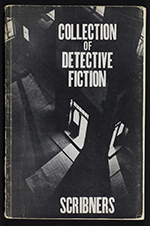
Lilly Library call number: PS2617 .A1 1841
Lilly Library call number: PS2617 .A1 1843 vault

The first separate appearance of The Murders. No second number ever appeared. The most valuable volume of American fiction. At the time Lilly acquired his, in 1929, it was the fifth recorded. The romantic story of this volume is told by the compiler of these notes in The J. K. Lilly Collection of Edgar A. Poe. There are still only about a dozen recorded. It is interesting to note that at least three unauthorized French translations are known to have appeared in the 1840's in newspapers.
Lilly Library call number: PS2618 .M99 1842
The second and longest of Poe's three major excursions into detective literature, based on an actual murder in New York City. Critics generally agree that it is the weakest of the three—an essay rather than a story.
Lilly Library call number: PS2618 .P9 1845
The first printing of the third of Poe's detective tales.
Lilly Library call number: PS2618 .P9 1844
By many considered Poe's finest achievement in the genre. Chevalier Dupin's deduction that the letter was hidden by not being concealed at all is still a favorite gambit of the craft. The version in Chamber's Edinburgh Journal was reprinted from The Gift in a condensed and inferior version. Despite the confusing date, that annual was published in September, 1844, and postdated, as was the custom at the time.
Lilly Library call number: PS2618 .T52 1844
Most critics disqualify this tale as a detective story on the grounds that Poe did not give the facts to the reader until after he had revealed the solution.
Ellery Queen disputes this conclusion vigorously in his The Detective Short Story—and who has the temerity to argue with Fred Danny? Not this compiler, who would rather argue law with a Supreme Court Justice.
"'Thou Art the Man'," states Queen, "is definitely a detective story and an important one historically. It contains the first use of the least-likely-person device; the first fictional instance of the laying of a false trail by the real criminal; the first use of psychological third degree to extract a confession and the first foreshadowing of the ballistics method of bullet identification. Also, another first, the detective is the anonymous narrator himself." So here it is on exhibit! As is its first appearance in bookform in Volume II of The Works of the Late Edgar Allan Poe, New York: J. S. Redfield, 1850.
Lilly Library call number: PS2612 .A11 1845

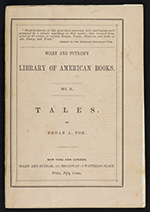
An immaculate copy, "No. II" in the publisher's "Library of American Books."
A complicated book bibliographically, all problems (especially of later bindings) have not yet been fully resolved.
It is certain, however, that this copy is of the first issue, with the slug of "Smith, Stereotyper and Ludwig, Printer" beneath the copyright notice and with perfect type on pages 196 and 204. There are twenty pages of terminal ads, beginning "Poetical Fortune Teller."
The rarest of the author's major works, no more than six correct copies in original wrappers being recorded.
Lilly's holdings of eight variant copies include the English edition, imported sheets with a cancel title, 1845 (not 1846, as usual); a presentation copy of the second state (Poe presentations are uncommon); The Tales and The Raven, bound together (New York, 1845); and other variants.
Queen calls this volume, which first prints in book form "Rue Morgue," "Marie Roget," and the "Purloined Letter": "the first and greatest, the cornerstone of cornerstones in any readers' or collectors' guide, the highest of all high spots."
Lilly Library call number: PS2602 .A1 1852a
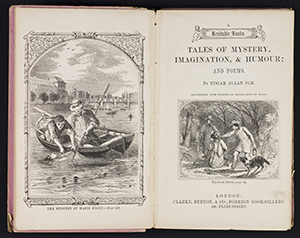
This small volume, "Illustrated with Twenty-six Engravings On Wood," is the first of Poe's works to contain illustrations. It is of interest that the title notes Poe's humour, a quality long overlooked in his own country which was given to stressing his drinking. No illustrated edition of Poe appeared in America in the nineteenth century.
Lilly Library call number: PS2612 .A15 1855
Lilly Library call number: PS2612 .A42 1856
Lilly Library call number: PS2612 .A42 1865
Lilly Library call number: PS2612 .A42 1927
Lilly Library call number: PR4622 .S9 1887 vault
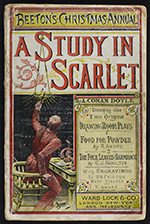
The first appearance of Sherlock Holmes: "That lurid paper-back of Christmas 1887 is today one of the rarest books of modern times—a keystone sought by discriminating collectors in every part of the world—flung like a bombshell into the field of detective fiction."— Vincent Starrett, The Private Life of Sherlock Holmes.
Lilly Library call number: PR4622 .S9 1888
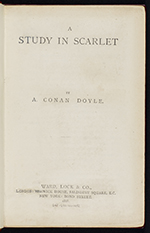
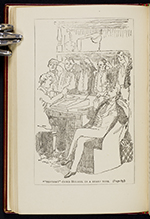
First edition with the correct spelling "younger" in paragraph 2, line 3, of the Preface, and with the correct ads. For a full discussion see the compiler's article "A Study of A Study in Scarlet: Or, A Scandal in Bibliography" in The Baker Street Irregular Journal, Vol. I, 1948.
This is by far the rarest of the Holmes' works and is one of the few rebound books admitted to the present exhibition. So scarce is it that the article above advises the reader to "get any copy you can, if you can, for it is highly unlikely that you will be lucky enough to ever have a chance at any at all."
The illustrations, line drawings, are by the author's father, Charles Doyle, "an artist," his son tells us, "more terrible than Blake." Terrible is the correct adjective
Lilly Library call number: PR4622 .S5 1890b
Despite Starrett's "bomb-shell" remark about A Study in Scarlet, it was an American publisher who saw the possibilities of Sherlock Holmes. An agent for Lippincott's Magazine at a dinner in London commissioned Doyle to write stories for his Philadelphia magazine.
One can imagine Holmes' great delight in making his second appearance in America, for he was, after all, an American (vide, The Three Garridebs): "I think the fellow (Holmes) is really an American but he has worn his accent smooth with years in London."
Lilly Library call number: PR4622 .S5 1890
The original manuscript of The Sign has just surfaced in Chicago.
Lilly Library call number: PR4622 .M5 1894
All of the Adventures and Memoirs originally appeared in The Strand magazine, copies of which are exhibited. The Adventure of the Card-Board Box was omitted from the English edition of Memoirs when the tales were gathered into book form on the ground that it involved an illicit love affair. Harper's, however, did not know of this and included it in their first issue. "As soon as this was discovered by Doyle he must have protested, because Harper's immediately issued a new edition (with "New and Revised Edition" on the title page) and very possibly suppressed or withdrew the first."—Scribner Holmes catalogue.
Lilly Library call number: PR4622 .R4
Sherlock returns from his wanderings in Tibet and elsewhere in the guise of a second-hand book dealer in the first tale, The Adventure of the Empty House. "A poor bibliophile who, either as a trade or a hobby was a collector of obscure volumes," Watson surmises. It was a perfect role for Holmes who was indeed an ardent collector as evidenced in The Red-Headed League where we are assured that he "was never so formidable as when, for days on end, he had been lounging in his armchair amid his black-letter editions."
Lilly Library call number: PR4622 .H7
"One cannot quarrel, in fact, with those idealists who maintain that Doyle's knighthood (in 1907) must have been a grateful government's recognition of this masterpiece, rather than the author's Boer War services which were officially assigned."—Haycraft.
Lilly Library call number: PR4622 .V2
The American edition precedes the English and differs radically textually and for an interesting reason. The story first appeared in The Strand magazine from September, 1914, to May, 1915. The American edition was reprinted from this.
In it Jake Shafter and his daughter Ettie were Germans. She spoke "with a pleasing little touch of a German accent" and her father with "more than a touch." In the English edition, however, Ettie is Swedish and Jacob Shafter, a "kindly Swedish boarding-house keeper." By the time the English edition was published World War I was on, and it was patently impossible to have Birdey Edwards marry a German lass, or to have any German depicted as a kindly character in an English publication. This was not true, however, at the time in America, where Doyle's original characterizations were not changed.
Lilly Library call number: PR4622 .H6
This volume contains the first English printing of The Card-Board Box, originally omitted from The Memoirs, as noted above. It is also the first printing of The Adventure of the Red Circle, the manuscript of which is on exhibition.
Lilly Library call number: PR4622 .C3
There are purists who refuse to admit that this, the final eleven "Adventures" and one "Problem" (that of Thor Bridge), are authentic. Nevertheless we have included it.
Lilly Library: English Literature mss.
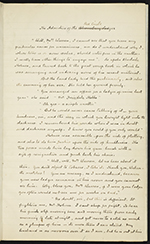
This Adventure took place January, 1897, and was first recorded in The Strand, March-April, 1911, which are also exhibited. Its first appearance in book form was in His Last Bow (London, 1917).
This sinister story with international complications leads Inspector Gregson of Scotland Yard at the end to say: "What I can't make head or tail of, Mr. Holmes, is how on earth you got yourself mixed up in the matter."
To which Holmes replied: "Education, Gregson, education. Still seeking knowledge at the old University." Which was, of course, a lifelong habit. Vide: The Adventure of the Three Students which, Watson remarks: "caused Mr. Sherlock Holmes and myself to spend some weeks in one of our great university towns—close to a library."
Lilly Library: Doyle mss.
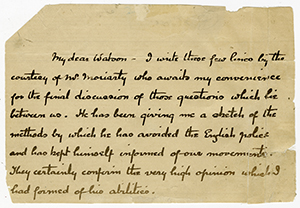
Doyle, bored with Holmes, rid himself (he thought) of his incubus by having Sherlock and Mr. Moriarty plunge to their mutual deaths in the struggle at Reichenbach Falls. Millions screamed in anguish, one lady addressing a letter to him beginning: "You beast!"
Sherlock left Watson a letter of explanation only the beginning paragraph of which is located (in the Lilly Library). It begins "My dear Watson. I write these few lines through the courtesy of Mr. Moriarty," etc. The compiler is on written record that should danger threaten the Lilly Library, the rescue of this noble fragment would receive top priority.
Lilly Library: English Literature mss.
Lilly Library call number: PS3537 .T18 U6
Lilly Library call number: PR4623 .A1 R2
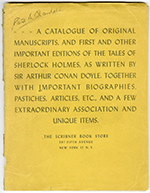
The first rare book catalogue to be devoted to a single detective, this contains the original manuscript of four of the tales from the Memoirs, priced $450 each, and the complete Valley of Fear, $1,500.
The "association items," such as An Inquiry into the Nature of the Ashes of Various Tobaccos (Tibet: Privately Printed, 1893) were dreamed up and annotated by Vincent Starrett and the compiler. Vide: Dukedom, pp. 149-59.
Lilly Library call number: HV7915 .V5
Lilly Library call number: HV7915 .V53
The Memoirs of Vidocq, crook turned cop, had an enormous influence on generations of future writers including Poe and Gaboriau who drew on his thrilling, and probably largely imaginary, exploits.
Lilly Library call number: PQ2257 .G2 A2 1866
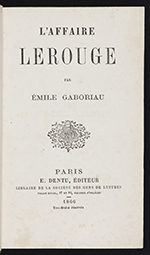
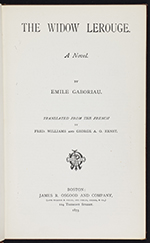
To this work falls the honor of being the first full-length detective novel. It is also a work of very considerable rarity. Carter remarks that "even early editions of Gaboriau's novels are almost impossible to obtain." Exhibited with this is the first American edition, The Widow Lerouge. Boston: James R. Osgood, 1873. It did not appear in England until 1885.
Gaboriau's novels were officially gazetted by his English publisher as "the favorite reading of Prince Bismark."
Lilly Library call number: PQ2220 .D6 C8
Boisgobey was the most popular of crime writers after Gaboriau and appeared in America as early as 1875—The Golden Tress being exhibited.
The link between Gaboriau and Leblanc, he is virtually forgotten today in his own country and completely elsewhere.
Lilly Library call number: PQ2220 .D6 D2
Lilly Library call number: PQ2623.E24 A78 (ALF)
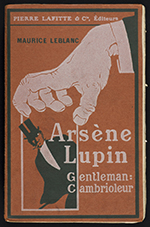
Lupin began as the gentleman-safe-cracker of the title of this first book. "Then, as more and more readers clamored for him to turn his brilliant talents to the pursuit of crime, a transitional period sets in, and he devotes himself to correcting the blunders of the official police, usually without their knowledge and to their discomfiture."—Haycraft.
Lilly Library call number: PQ2623.E24 A7613 1909 (ALF)
Either just before or just after the publication of The Fair-Haired Lady, it was decided to change the title. Signature A was reprinted. Both copies have a sixteen-page catalogue dated Spring, 1908. It was later reprinted as The Arrest of Arsèene Lupin (London: Nash, 1911), which is also exhibited. Why the work should be repeated retitled is, indeed, a mystery.
Lilly Library call number: PQ2623.E24 H9 (ALF)
Lilly Library call number: PQ2623.E24 H92 (ALF)
Generally considered the author's masterpiece. He had one of the most successful careers in French letters, culminating in the ribbon of the Legion of Honor. He survived until 1941 and did not die in 1926 as Willard Huntington Wright (who had notable troubles with necrology, vide Anna Katherine Green) reported.
Lilly Library call number: PQ2623 .E6 M9
Lilly Library call number: PQ2623 .E6 P4
Complicated bibliographically, identifiable by the first issue having yellow pictorial wrappers, the second rose. Very popular in his day, Leroux is unread today, though important historically. He is remembered chiefly as the author of the still popular The Phantom of the Opera (1910).
Lilly Library call number: PQ2637. I53 P398
Lilly Library call number: PQ2637. I53 M754
Lilly Library call number: PR4573.5 .H8
This contains four articles by Dickens on the new police force. " Sir Robert Peel's creation of the police force dates from 1829 but it was only in 1845 that the germ of the Criminal Investigation Department was born. In that year Sir James Graham detailed twelve police officers for exclusive plain clothes detective work: Dickens was the first writer to recognize their importance."—Carter
Lilly Library call number: PR4556 .A1
As Haycraft points out, Bleak House is only in small part (fourteen of sixty-six chapters) devoted to detectives. Yet, as he notes, Inspector Buckett, based on Dickens' personal friend, Inspector Field of the London Metropolitan Police Force, "remains, if nothing else, the first English fictional detective; and as such he needs no apologies."
Lilly Library call number: PR5271 .R8 R2
Lilly Library call number: PR4529 .D404 D4
It is of interest to note that the publishers, who later issued Doyle and others, were interested this early in the genre.
Lilly Library call number: PR5549 .T4 T5
An extremely popular play, which went through many editions. The only detective play in the exhibit, but: "I am Hawkshaw, the detective!" could not be omitted.
This enormously prolific playwright is perhaps now only remembered for the above and his authorship of Our American Cousins, the play Lincoln attended, April 14, 1865.
Lilly Library call number: PR4494 .M8 vault
Lilly Library call number: PR4494 .M8 1868
Lilly Library call number: PR5470 .S34 U7
The plot of this story has some resemblance to that of The Moonstone (1868) and the author, in a prefatory note, finds it necessary to state that it was independently achieved.
Lilly Library call number: PR4879 .L7 C4
The first work to use plastic surgery and dental records as criminal identification.
Lilly Library call number: PR5282 .I8
By the famous author of sea stories (notably The Wreck of the Grosvenor), whose work was praised alike by Herman Melville and Sherlock Holmes.
Lilly Library call number: PR4699 .F17 D3
Lilly Library call number: PR4731 .M5 1888a
Lilly Library call number: PR4809 .H87 M8
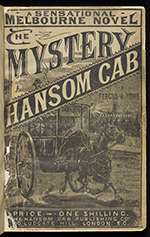
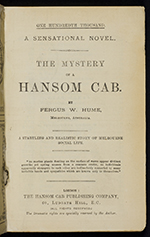
A very few earlier copies of the London edition are known and four of the original Melbourne printing, 1886.
The sensational detective fiction best seller of all time. The author, a New Zealander, born in England of Scottish descent, wrote this, his first book, when he was twenty-seven and a barrister's clerk in Melbourne.
The author sold the copyright to speculators for fifty pounds who issued it in England at the rate of 25,000 copies a month for fourteen months.
By the turn of the century over five million copies are reputed to have been sold, and as late as 1959, Hutchinson issued an edition of 20,000.
In an Appendix to Glover- Greene's Victorian Detective Fiction, Eric Bell gives an account of its publishing history. The Lilly copy is recorded as one of six copies known of the fifth edition—there being only eleven copies in all of earlier issues.
"For some unfathomable reason this shoddy pot-boiler— scarcely readable today—belongs among the famous 'freak books' and is mentioned here for its historical interest only."—Haycraft
Lilly Library call number: PR6015 .O29 A8
The first appearance of "Raffles," a highly popular Robin Hood, created by Conan Doyle's brother-in-law, who commented that: "Though he might be more humble there's no p'lice like Holmes."
"Raffles" had a hero's death in the South African War but was later resurrected (after his creator's death) for further adventures but, like Sherlock, he was never quite the same man.
Lilly Library call number: PR4782 .H7 C6
Lilly Library call number: PR4007 .A7 Q8
There are very few "two-decker" novels, compared with the standard three volume work of the period, and this is the only such detective story the library possesses.
Lilly Library call number: PR5101 .M36 M2
"Dick Donovan" wrote more than fifty detective tales. This is one of his best-known.
Lilly Library call number: PS1759 .G15 C6
The first work of an author whom, Carter states, "ill deserves oblivion." This is possibly because his works are so uncommonly found, Eric Quale, for instance, confessing that the present work has "so far eluded me."
Lilly Library call number: PR5089 .M15 M3
Lilly Library call number: PR6031 .E5 J5
Lilly Library call number: PR6037 .H63 P9 1895
Lilly Library call number: PR4728 .G84 R7
"Amusing and not-too-unfair presentation of French officialdom at work on a sleeping-car murder, while a British general protects the rights of a lady suspect in distress—not much detection but plenty of Paris as it was."—Barzun -Taylor.
Lilly Library call number: PR5453 .S6 S8
"Semi-science stories emphasizing hypnotism, Spencerian psychology, and the new ideas of the day. Despite occasional implausibility, readers with a sense of period will find their interest sustained, especially if they have a taste for well-managed English locale."—Barzun -Taylor.
Lilly Library call number: PR5452 .S4 D6
"A female investigator of considerable quality."— Wright.
Lilly Library call number: PR6015 .U6 I9
Milne's Express Series No. 4. Only the first impression of books in this series was bound in cloth, later impressions in boards.
Lilly Library call number: PR6003 .O3 P2
Lilly Library call number: PR6003 .O3 D6
Possibly the only Q. C. who ever wrote in the genre. His Recollections of an Irish Judge was published in 1914. Paul and Dora were eventually married "this inaugerating," says Ellery Queen, "what is possibly the earliest family in mystery fiction." For in a later book, Young Beck (London: Unwin), a son is born, and eventually Paul, Jr. becomes a detective in his own right.
Lilly Library call number: PR6023 .E56 M6
The murderer turns out to be the detective himself, the probable first use of this unacceptable ploy which violates Father Knox's rule seven.
Lilly Library call number: PR6031 .A25 M5
Dix is a Raffles, Robin Hood-type, sermonizing crook, specializing in confidence tricks, and his Memoirs are told from the culprit's viewpoint.
Lilly Library call number: PR6011 .R33 R3 (ALF)
Lilly Library call number: PR6011 .R33 S6 (ALF)
This volume of "inverted tales" made Freeman's reputation. "He eliminated one aspect of suspense and concentrated on intellectual deduction in which we see the crime committed and then watch Thorndyke reveal the criminal."—Symons.
Lilly Library call number: PR6011 .R33 M9 (ALF)
Here, Thorndyke locates a house, to which an accomplice is driven in a blacked-out cab, by the construction of a track chart based upon time, compass bearings, and horses' hoofbeats per minute. Furthermore, he writes a preface explaining how the method used was practical.
Lilly Library call number: PR6029 .R25 O4
Lilly Library call number: PR6029 .R25 L2
"We of the Female Department are dreadfully snubbed by the men, but don't tell me that women have not ten times as much intuition as the blundering and sterner sex."
Baroness Orczy is best-known for her adventure stories, notably The Scarlet Pimpernel, but The Old Man and Lady Molly are still reading treats.
Lilly Library call number: PR6025 .A79 A8 (ALF)
"Hanaud may almost be regarded as the Gallic counterpart of Sherlock Holmes."—Wright.
Lilly Library call number: PR6025 .A79 H8 (ALF)
A milestone in the genre though there are those who complain that Hanaud did not play fair with his Watson.
Lilly Library call number: PR6015 .A6 M5 (ALF)
Cleek, like many another, turned from crime to law enforcement. His mobile features baffled everyone: in fact they couldn't tell a hawkshaw from a Hanshew. Carter remarks that "the stories must be read to be believed."
Lilly Library call number: PR6005 .H5 I48
The first of this famous series. "With his psychological approach to the problems of human frailty, and his endowment of the guilty with good as well as bad qualities, Chesterton's works of detective fiction assume a special importance in the genre, while Father Brown whose most 'conspicuous quality was not being conspicuous,' will be remembered as one of its most endearing characters."— Quale.
Lilly Library call number: PR6025 .A72 J9 (ALF)
"Judith Lee, while not technically a sleuth, happens upon the secrets of many crimes through her ability as a lip reader."—Wright.
Lilly Library call number: PR6023 .O95 L5
A "fringe" detective story but a very fine fictional analysis of Jack-the-Ripper.
Lilly Library call number: PR6037 .M425 E9 (ALF)
Lilly Library call number: PR6037 .M425 M4 (ALF)
Lilly Library call number: PR6011.L5 A8 (ALF)

An antiquarian and journalist, this is by all odds Fletcher's rarest work, though not his first, as has been claimed. His The Middle Temple Murder (1918) was praised by Woodrow Wilson, which produced results akin to President Kennedy's praise of Ian Fleming—immediate popularity in Britain and the U.S.A.
Lilly Library call number: PR5922 .G7
Contains the famous story, much anthologized, The Big Bow Mystery, a locked-and-barred room yarn. Zangwill was a very popular romanticist (The Cardinal's Snuff-Box, etc.), and this is his only venture into the genre.
Lilly Library call number: PR6045 .A3 F7 1905
Lilly Library call number: PR6039 .R2 S8
Louis Tracy also wrote under the pseudonym Gordon Holmes featuring Inspector Furneaux (mostly adventure mysteries) and collaborated with M. P. Shiel.
Lilly Library call number: PR1309. R3 W58
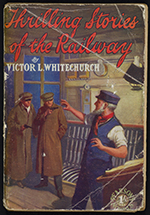
"A remarkable and inexplicably neglected book"—Carter, "Detective Fiction." With Father Knox, Canon Whitechurch is one of the few men of the cloth who have written in the genre.
"A slight, delicate-looking man, with pale face and refined features, light red hair, and dreamy blue eyes. Such is a brief description of Thorp Hazell, book-collector and railway enthusiast, a gentleman of independent means, whose knowledge of book editions and bindings was only equalled by his grasp of railway details."
Lilly Library call number: PR6003 .E67 T69
This "acknowledged masterpiece" (Sayers) by "the father of the modern detective story" (Carter) could not find a publisher in England until it had been accepted in America. It is reputed to have appeared simultaneously in both countries.
The author, versatile journalist, author of nonsense verse, inventor of "Clerihew's," did not write another detective story for twenty-three years.
Lilly Library call number: PR6005 .R73 C3 (ALF)
Crofts' first detective novel, reflecting his musical interests. "A book not only of very remarkable quality but one which has profoundly influenced the modern detective story as a whole."— Carter. Its central theme is the painstaking demolition of the "unbreakable" alibi.
Lilly Library call number: PR6005 .R73 I52 (ALF)
A major case in Inspector French's early career. French gets to France, as usual, to solve this one.
Lilly Library call number: PR6003 .A374 C15 (ALF)
The first Reginald Fortune book. The author, a classical scholar (First Honors) at Corpus Christi College, Oxford, turned to detective stories "as a relief" from war correspondent duties in 1914-18. The resemblance between Mr. Fortune and Chesterton's Father Brown has frequently been noted.
Lilly Library call number: PR6003 .A374 G2 1932
The first Joshua Clunk book. The crook's solicitor: "It was commonly said that he knew more of what was going on underground than any man in London, and not uncommonly believed that he was up to his neck in most of it."
Lilly Library call number: PR6005 .H7 H9747 1921
The prolific and enormously popular author's first detective story.
Printer's proof taken from the imported American sheets. There are a number of corrections in the margins, several cancel pages, and engravers' proofs for the plates on pages 42 and 60 are inserted.
Published in England on January 26, 1921; in U.S.A. before the end of September, 1920. It is interesting to note the number of English classics in the genre first published in America, and how popular the American "hard-boiled" types are there.
Lilly Library call number: PR6005 .H7 M9745 1926
Lilly Library call number: PR5177 .R3
The prolific and long-lived (ninety-eight years) author wrote a number of detective stories.
In this fascinating orgy of blood, the last of the three Redmayne brothers, Albert, who is a book collector, visits the house on the cliff where his brother Bendege had made his home and went through its scanty library. He found nothing in it of any interest to a collector but, adds Mr. Phillpotts, "the ancient and well-thumbed copy of Moby-Dick he took for sentiment."
Lilly Library call number: PR5177 .T3
"The Thing at Their Heels, though ignoring the accepted canon of detective-story writing, must be placed in this category [the first rank] with an asterisk of distinction marking it."—Wright.
Lilly Library call number: PR6025 .I65 R29
The author's first and only such tale. In a famous essay, "The Simple Art of Murder," Raymond Chandler attacked the classical detective story, using this work to show how it violated the plausible in action, motive, police routine and the expression of human feeling. It might be said of the author (though Chandler does not do so), that he went from bad to verse.
Lilly Library call number: PR6005 .O27 B7 (ALF)
The author's first detective work and the only one done without collaboration with his wife. It was written, he says, "during an illness, as he had been told not to work, and found the prospect intolerable."—Haycraft. The case has to do with Sir Vernon Brooklyn, builder of the Picadilly Theatre, London, no connection to the New York Brooklyn murders, of which there have been plenty.
Lilly Library call number: PR6037 .A95 W6
The author's first book. Miss Sayers was one of the first women to receive an Oxford degree, taking first honors in medieval history. From this background comes the erudite nobleman detective. "A stunning first novel that disclosed the advent of a new star in the firmament and one of the first magnitude."— Barzun- Taylor.
Lilly Library call number: PR6037 .A95 G2
"With Gaudy Night—she definitely attempted to achieve a new form—it introduced a psychological—murderless mystery."—Haycraft.
Lilly Library call number: PR6037 .T8 A2 (ALF)
Major Street, under his own name, was the author of a number of works on international politics. This story of drug traffic was published in America as The White Menace —typical enough today!
Lilly Library call number: PR6037 .T8 P2 (ALF)
The first of his ursine mathematician's cases which continued at the rate of one to three a year.
Lilly Library call number: PR6005 .O97 L4
The author, like so many British writers of detective stories of the times, prepared for the bar and later entered journalism. This is his first detective novel and Roger Sheringham, the author admits, "is an offensive person, founded on an offensive person I once knew, because in my original innocence I thought it would be amusing to have an offensive detective."—Haycraft.
Lilly Library call number: PR6021 .N8 V6 (ALF)
Probably Father Knox's best-known detective tale as well as his first.
Lilly Library call number: PR6025 .A1925 R2
This, the author's first detective novel, rated very high in its day. The sleuth is a military-minded Colonel who went on to other mysteries.
Lilly Library call number: PR6039 .R52 M9
James Hilton's only detective story.
Lilly Library call number: PR6005 .O97 M2
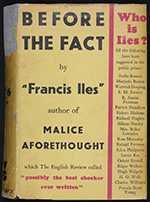
This famous yarn, not really a detective story, begins: "It was not until several weeks after he had decided to murder his wife that Dr. Bickleigh took any active steps in the matter. Murder is a serious business. The least step may be disastrous. Dr. Bickleigh had no intention of risking disaster." Take it from there! The first "Francis Iles" work. Also exhibited, Before the Fact.
Lilly Library call number: PR6045 .H2 D2
The only detective story by the author of "The Sword in the Stone," etc. Almost unknown, or at least not mentioned by any authorities we have consulted.
Lilly Library call number: PR6007 .A95 Q5
The poet's first detective novel, a prep school yarn. "From the year of his marriage (1928) until 1935 he taught in several schools to support his growing family. This, however, did not give him the leisure he desired for his poetry and he turned to writing detective stories under the "Blake" nom de guerre for the frank purpose of supplementing his income. This attempt was so successful financially that he was soon able to give up teaching altogether."—Haycraft. But not poetry.
"Often the very writers who can invent the best detective puzzles are those who invent the most intolerable detective heroes. Think of all ... those Scotland Yard policemen who are married to lady artists! I must confess a weakness for Mr. Day Lewis's Nigel Strangeways, because some of his habits were taken from mine."— W. H. Auden, "Detective Fiction."
Lilly Library call number: PR6025 .A71 D2
The case of The House of the Sacred Flame. The investigators are: Chief Detective-Inspector Alleyn, Criminal Investigation Department, Scotland Yard; Detective-Inspector Fox, his assistant; Detective-Sergeant Bailey, his fingerprint expert; Dr. Curtis, his Divisional Surgeon; and Nigel Bathgate, his Watson. One of the earliest and best of New Zealand born Dame Edith Marsh, C.B.E., numerous works.
Lilly Library call number: PS2590 .P5 E9
The first of the many Pinkerton volumes, included because of its historical significance as the American counterpart of Vidocq, "Waters," etc.
Lilly Library call number: PS2732 .L4 1878
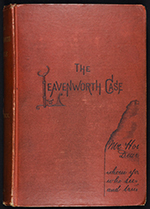
The first American full-length example of the genre and universally acclaimed. "One of the best detective stories ever written."—Stanley Baldwin.
S. S. Van Dine solemnly wrote an introduction to a "memorial" edition, published in 1924, both he and the publisher believing she was dead. Actually she was very much alive, aged a mere seventy-eight and lived another eleven years.
Lilly Library call number: PS2732 .F4
Pre-Watergate doings in our Capitol City.
Lilly Library call number: PS1025 .S8
The second full-length American detective story.
Lilly Library call number: PS3114 .V4 D2
Extremely popular in England where Ward, Lock & Routledge issued her in sixpenny edition in the 1880's, later in pictorial cloth.
Lilly Library call number: PS3531 .O8 S8
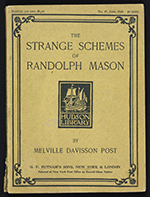
The author's first book. The last paragraph of the final story, "The Animas Furandi" reveals the method of Mason's strange schemes. "Parks, he muttered—Parks this ship is worth a million dollars. Come with me to the cabin and I will show you how it can be wrest from the owners and no crime committed; do you understand me Parks? no crime!".
Lilly Library call number: PS3531 .O8 C82 (ALF)
Being tales of Randolph Mason as related to his private secretary, Courtland Parks. Mason "began as an unscrupulous lawyer who used his knowledge of legal loopholes to defeat justice" but with this volume "Post was forced to follow the course of Leblanc with Lupin in France and Hornung with Raffles in England—to heed popular demand and finally put his hero on the side of law and order."— Haycraft.
Lilly Library call number: PS3531 .O8 U54 (ALF)
A rockhewn Virginia squire, whose position as protector of the innocent and righter of wrongs in his mountain community compelled him to turn detective with some of the most convincing results known to the short story form.
Post is "probably the most creditable exponent of the formalized short story that America has developed (and) brought to the detective story a new technical excellence that was to have far-reaching effects."— Haycraft. One of Post's stories "The Corpus Delicti" is credited with having hastened a long needed change in criminal procedure.
Lilly Library call number: PS1847 .D2
Julian Hawthorne, son of Nathaniel, "produced crime and near-crime fiction near the turn of the century which some connoisseurs feel has been unfairly neglected. Charles Honce writes 'he was half a century too soon.'"—Haycraft.
Lilly Library call number: PS1284 .T7
"On the basis of five stories in this book The Tracer of Lost Persons can only be described as a love-detective."— Queen.
Lilly Library call number: PS3535 .I42 C49
Lilly Library call number: PS3535 .I42 M19 (ALF)
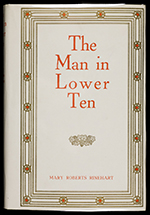
Her first novel, written while recuperating from an operation, was serialized in 1907. This tale of forgery and blackmail begins with the wrecking of "The Washington Flyer." Aggressively advertised by her publishers it was said that the berth "Lower Ten" was unsalable in Pullmans for some time after its publication.
Lilly Library call number: PS3501 .D317 A9
The author's only excursion into the field. Average, so called because his parents named him Adrian Van Reypen Egerton Jones. "The tales were well above the level of their era, both in conception and style."—Haycraft. Two of the eleven short stories are outstanding: "The One Best Bet" and "The Man Who Spoke Latin."
Lilly Library call number: PS2584 .P2 C55
Lilly Library call number: PS3535 .E31 B6
The first English edition of Reeve's first novel published in America the same year under the less explicit title The Silent Bullet.
The "American Sherlock Holmes," was extremely popular for a decade. But, as Hayward remarks, "It is doubtful if any other fictional sleuth of similar temporal prominence has fallen so completely into limbo."
Reeve, as so many others have, based his detective on an actual person, Dr. Otto H. Schultz, sometime medical adviser to the district attorney of New York. And though Kennedy's "science" dramatizing the mechanical wonders of his times is absurdly dated, it is to his credit that he applied Freud to detection twenty years before the general public ever heard of psychoanalysis.
Lilly Library call number: PS3537 .T482 M99 (ALF)
"The only acknowledged librarian-writer of detective fiction—[this] is frequently singled out for its jigsaw quality."—Haycraft.
Lilly Library call number: PS3545 .E533 B7 (ALF)
Miss Wells published over seventy-five mystery novels almost all featuring the same detective. An enormous worker—she produced close to 200 volumes—she may finally be remembered as an early and enthusiastic devotee, collector, and first bibliographer of Walt Whitman.
Lilly Library call number: PS3503 .U85 P56 (ALF)
Lilly Library call number: PS3529 .S84 A8 (ALF)
"An almost unique example of the detective story told from the point of view of the hunted rather than the hunter."— Sayers.
Lilly Library call number: PS3503 .O935 B74
Lilly Library call number: PS3539 .R23 T96 (ALF)
Though not strictly detective stories, these famous tales of Mr. Tutt of the stogy and stovepipe hat, defender of the innocent, and remarkable lawyer, were extremely popular and foreshadowed Perry Mason. Originally serialized in the Saturday Evening Post.
Lilly Library call number: PS3543 .A18 R32 (ALF)
The author's "Apology" states: "This tale quite brazenly derives from the author's invention for a motion picture produced in the autumn of 1919.
It is only fair to state, however, that the author has in this version taken as many high-handed liberties with the version used by the photoplay director as the latter took with the original. The chance to get even for once was too tempting . . . ."
Lilly Library call number: PS3503 .I24 H8
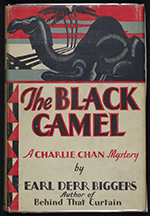
The first of this very successful series. Father Knox had proclaimed in "The Art of the Mystery Story" that "a Chinese character should never figure in a mystery story" although he confessed he didn't know why.
In this first tale, Charlie was a Chinese-Hawaiian assistant detective—possibly based on Chang Apana, one of the few Chinese members of the Honolulu police force. Originally he had something of the "sinister and wicked Chinese," about him though more akin to Bret Harte's "Ah Sin" than to Rohmer's "Fu Manchu."
But Biggers grew to like him, promoted him to the rank of detective sergeant and furnished him with a large family. "The great detectives are seldom married and even more seldom do they have home lives. Chan was the first and most successful 'domestic detective.' "—Neil Ellman in The Indiana University Bookman, March, 1967.
Also exhibited is The Black Camel.
Lilly Library call number: PS3543 .A3 B39 (ALF)
The beginning of a famous series. Based on the murder of the bridge expert Joseph Ewell in 1920.
Lilly Library call number: PS3543 .A3 S2 (ALF)
Lilly Library: American Lit. Mss.
Lilly Library call number: PS3505 .A7283 S4
One of newsman Casey's most memorable efforts was his amusing study of the mores of the British school of mystery writers, "Oh, England! Full of Sin" which appeared in Scribners Magazine, April, 1937.
Lilly Library call number: PS3533 .U4 R7
The first work of these notable collaborators, each subtitled "A Problem in Deduction." From the very start Ellery demonstrates his bookishness.
Lilly Library call number: PS3533 .U4 T7
The first of the Drury Lane, ex-Shakespearian actors' tragedies.
Lilly Library call number: PS3505 .A72 I88 (ALF)
Carr's first detective story and the beginning of a remarkable career.
Lilly Library call number: PS3505 .A72 B78 (ALF)
Lilly Library call number: PS3505 .A72 B64 (ALF)
This precedes the English edition by a month. One of the earliest of the Harper "Sealed Mystery" stories.
Lilly Library call number: PS3509.B4 P3 (ALF)
Considered by some to be the best of her large output, this is her first book. "Her stories exemplify many of the best characteristics of the Rinehart School."—Haycraft.
Lilly Library call number: PS3515 .A42 M18
Lilly Library call number: PS3515 .A42 T4
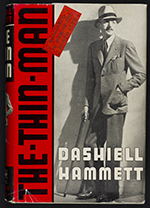
Published at $2, the price of an average-size novel then, this is 260 pages. The dust jacket bears the note, of some historical interest: "This book will not appear in a cheaper edition before 1935. Whether it does so appear at that time or later will depend on how large a sale it enjoys during the first two years it is on sale. Usually it is possible to produce cheap editions only of those books that sell widely at the original price." Also a well-known movie series starring William Powell and Myrna Loy. The dust jacket bears on front cover and spine a picture of the author.
Lilly Library call number: PS3539 .A9635 C2
The first Asey Mayo story. As "Alice Tilton" Miss Taylor also writes the hilarious Leonidas Witherall stories.
Lilly Library call number: PS3513 .I26 L78
Lilly Library call number: PS3529 .U8 A63 (ALF)
Police Commissioner Thatcher Colt, always in impeccable attire, possibly satirizes New York's Grover Whalen.
Lilly Library call number: PS3503 .L144 R2
Vincent Starrett's copy with his pencilled note: "First and probably only edition of a good detective novel." The detective is an American scientist living in London. The author's first, of only two, detective novels.
Lilly Library call number: PS3513 .A687 C97
Lilly Library call number: PS3513 .A687 D61
The fifth of this famous series, still advertised as "the book actually used to convict a murderer in Arizona," which it did.
Lilly Library call number: PS3513 .A687 B5
How, literally, to get away with murder.
Lilly Library call number: PS3537 .T733 F34
The beginning of a famous series. Probably the first time murder is committed by (not in) a golf club.
Lilly Library call number: PS3537 .T733 L43
The second Nero Wolf book by Hoosier-born Stout. Haycraft remarks that in his opinion this is the one example "of a Watson who steals the play from his Holmes, and a first rate Holmes to boot." And Stout is on record as feeling that anyone who doesn't read detective stories is a Communist.
Lilly Library call number: PS3523 .O218 M67 (ALF)
The first Mr. and Mrs. North work. As with Elliot Paul, the Lockridges combined humor with murder.
Lilly Library call number: PS3537 .T18 G75
Starrett relates how the movie version of this was so changed he had to sit through the whole show to discover how it ended.
Starrett's favorite detective creation bore the attractive name Jimmy Lavender, after his favorite old-time Chicago Cub's pitcher.
Lilly Library call number: PS3525 .A424 M26 1936
"Oscar Morgan found him in a speakeasy and took pity on him. He hadn't been clean that day and he certainly wasn't sober." (p. 31)
Lilly Library call number: PS3521 .U5 F25
A most entertaining story of the rare book world. If memory serves, the author, a dealer himself, or rather scout, was known at the time as "The Hollywood Kid."
Lilly Library call number: PS3535 .I217 E34 1939 (ALF)
The first appearance of this "wacky" pair.
Lilly Library call number: PS3513 .R866 F87 (ALF)
The detective is a book salesman as, at one time, was the author. His first work.
Lilly Library call number: PS3523 .E332 G89
"'Making with the book words,' this tale is set at 'The Old Opera Theatre' with its four-a-day, pin spots, gazeeka boxes, grouch bags, pickle persuaders, cash-register hearts and three corpses."—Dust jacket blurb.
Lilly Library call number: PS3507 .A45 D27
The detective "followed the occupation of consulting expert on old or pseudo-old books, manuscripts and autographs."
Lilly Library call number: PS3505 .H26 B5
The first of the author's scanty output of seven novels, done when he was fifty-one. This became a movie, starring Bogart and with dialogue by Faulkner.
Lilly Library call number: PS3505 .H26 F22
The author's second book, considered by himself to be his best. A newspaper man, he began writing for Black Mask at the age of forty-five, and Philip Marlowe is in its best tradition.
Lilly Library call number: PS3505 .H26 L3
Chandler has become a symbol of "An American Genre," and his work, literature. Marshall McLuhan has compared his detective to "Christopher Marlowe's superman Tamburlaine and Dr. Faustus." And recently there has been an article stating that in his work "there is Fitzgerald's tone of disenchantment and cynicism, Nathaniel West's exaggerated humor and rueful tenderness, Hemingway's melancholy and brooding and Faulkner's decadence and stubborn endurance." And the same article, going back a little in time, claims Chandler as "in the tradition of a negative romanticism which is perhaps the dominant mode of American fiction from Hawthorne to our contemporary black humorists— that power of darkness which Hawthorne, Poe and Melville explored, which Mark Twain could not laugh away," etc.— E. M. Beekman, The Massachusetts Review, Winter, 1973. Despite this horrendous handicap, they are excellent reading.
Beginning with Discovery, exhibition catalogues and other publications from The Lilly Library are numbered consecutively.
A list of the unnumbered publications (most are out of print) issued prior to this series follows:
Designed and edited by the Indiana University Office of Publications, fifteen hundred copies of this catalogue have been printed. The text is set in 10-point Helvetica; the stock is 70-pound white offset.